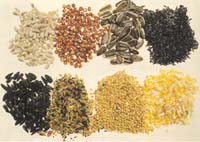How Many Birds
If too many birds at your feeder become a problem, you can control their numbers by putting out smaller amounts of seed, or by using specialty seeds or restrictive feeders that will attract only certain species. If you fill your feeder only when it’s empty, the birds will look for food elsewhere. You can encourage small birds and discourage large birds with feeders that restrict access. Wood feeders with vertical bars and feeders covered with wire mesh frustrate larger birds. The most non-selective feeders are the tray, platform or house feeders because they allow easy access by all birds. Tube feeders without trays also restrict access to only small birds. Remove the perches, and you’ve further restricted the feeder to only those birds that can easily cling – finches, chickadees, titmice, and woodpeckers. If starlings are a problem at your suet feeder, discourage them by using a suet feeder with access only from the bottom. Starlings are reluctant to perch upside down. Chickadees and woodpeckers don’t find that a problem. You can virtually eliminate visits by birds you would rather not see by offering seeds they won’t eat. If you use more than one type of seed, put them in separate feeders. This will reduce wasted seeds, as birds will toss unwanted seeds out of a feeder to get to their favorites Watch a feeder filled with a seed mix and you’ll see the birds methodically drop or kick out most of the seeds to get to their favorite-sunflower.
Many birds prefer sunflower. Some prefer millet. A few prefer peanuts. Sparrows, blackbirds, doves, and juncos will eat the other grains used in pre-made mixes: corn, milo, red millet, oats, wheat, and canary seed. Birds will also kick out artificial “berry” pellets, processed seed flavored and colored to look like real fruit. Black oil sunflower is the hands-down favorite of all the birds that visit tube and house feeders. Birds who visit platform feeders (doves and sparrows) favor white proso millet. Ducks, geese, and quail will eat corn. Many cereal grains (corn, milo, oats, canary, wheat, rape, flax and buckwheat) in mixed bird seeds are NOT favorites of birds that visit tube feeders. The most effective way to attract the largest variety of birds to your yard is to put out separate feeders for each food:
|
Other Links:
- For the birds
- Back yard bird feeding
- Bird Feeder Selection
- How Many Birds
- Birds Attracted by Various Feeders and Foods
- Uninvited Guests at the Birdfeeder
- Questions about Feeding Wild Birds
- Homes for Birds
- Selecting a Bird House
- Bird House Design
- Bird Nest Box Dimensions
- Bird House Placement
- Protection from Predators
- Attracting Birds
- Landscaping for Birds
- Basics of Landscaping for Birds
- Plants for Wild Birds
- How to Get Started
- Protecting Bird Habitat
- Additional Readings

